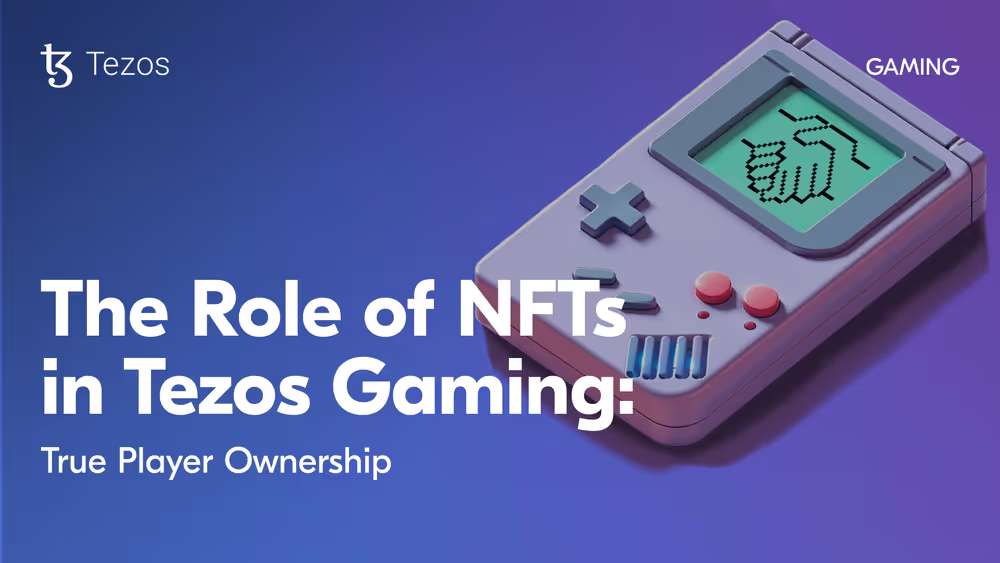The Role of NFTs in Tezos Gaming: True Player Ownership
From Assets to Achievements: How Tezos NFTs Redefine Gaming
6 minute read

Progress and rewards are at the core of gaming — leveling up, earning rare items, and unlocking achievements. But in most games, those rewards are temporary. If a game shuts down, everything you’ve earned is gone, stored on servers you don’t own.
Tezos-powered games give players more control over their digital items. Instead of being locked in a single game, NFTs let players own, trade, and carry assets across different experiences. Some games are already experimenting, showing how blockchain can make in-game progress and rewards more permanent.
Why NFTs Matter in Gaming #
Unlike traditional gaming models, the items players earn while playing the game remain locked to a single platform. If the game shuts down, everything disappears. NFTs change this by putting digital assets on the blockchain, where players can trade, sell, or — when supported — use them across different games. For those who invest time and money into in-game collections, this adds a level of permanence traditional games can’t offer.
NFTs change how in-game assets work. Instead of being tied to a single platform, items live on the blockchain, where players own them. A BattleRise hero, a racehorse from Stables, or a Fantasy United card isn’t just in-game rewards. Players can trade, sell, or use them in other games when developers allow it. They have control over their digital assets rather than being stuck in a closed system.
Some in-game items stay the same no matter how much time you put in. Others tell a story. On Tezos, NFTs can carry a player’s history — wins, milestones, and hard-earned progress — permanently on-chain. Players create them instead of just collecting items, shaping their value through play.
Dynamic NFTs: Collectibles That Evolve #
In usual gaming scenarios, everything a player earns stays inside that world. When the servers shut down, so does their progress. On-chain items change that. Players record where they’ve been, what they’ve achieved, and how they’ve grown — regardless of the game’s fate.
A general’s reputation isn’t just about numbers on a stat sheet. Victories matter, but so do the close calls, the risky maneuvers, and the battles barely won. Every campaign they fight changes them, and other players take notice.
In most racing games, cars don’t change. You can put a thousand miles on them, slam into walls, and nothing sticks. You start the next race, and it’s like nothing happened. But what if your car wore down? If a rough race meant the vehicle would handle differently next time, that’s what’s happening here.
Run it hard, and you’ll feel it. Push your engine too far; it might need work before the next event. But keep it in top shape, and maybe someone else will want to buy it from you because they know what it’s been through.

Play-to-Own vs. Play-to-Earn #
Early blockchain games focused on play-to-earn, rewarding grinding with monetary payouts — but that model often collapsed under its weight. Now, games are shifting toward play-to-own, where digital assets have value beyond speculation.
Stables and Fantasy United integrate NFTs in ways that deepen engagement. Players collect, trade, and use in-game assets as part of the experience, not just as a means to cash out. Ownership matters, but it doesn’t replace gameplay — it supports it.
Counterfeit cards and shady trades have always been a problem in collectible card games. Without a way to verify authenticity, players risk getting scammed. Blockchain changes that. Every NFT card is tied to a public record, proving its legitimacy and tracking every trade — no disputes, no forgeries.
Rare cards have always had value, but in traditional games, proving what’s genuine can be a hassle. Counterfeits slip into the market without a way to track ownership or authenticity, and trades rely on trust. Fantasy United solves this by recording every trade on-chain, so players can see exactly where a card has been and who owns it now — no middlemen, no forgeries.
These aren’t just static collectibles. A card earned in one game could be used in another, carrying its history with it. Ownership means something, whether it’s a tournament-winning deck or a prized first-edition pull.
NFTs work best when they feel like they are part of the game, not a separate marketplace. In a play-to-own model, players aren’t farming rewards to cash out — they’re making decisions that affect their assets over time. A rare card gains value through its use, not just its existence. A well-bred racing horse might dominate tournaments or get rented out to other players. These mechanics keep the game economy driven by gameplay, not short-term speculation.
Looking Ahead: NFTs Beyond Cosmetics #
True interoperability sounds great — take an item from one game, use it in another — but the reality is messy. There’s no universal format for NFTs, so assets often can’t carry over between games. Game engines usually fail to recognize each other’s metadata, and smart contracts don’t naturally communicate across different networks.
Even when the tech is possible, not every studio wants it. Some worry about breaking game balance, while others don’t see a reason to support assets they didn’t create. Until developers find common ground, seamless cross-game NFTs will stay more theory than practice.
Some Tezos projects are working on a shared standard for NFTs, making them easier to use across different games. Most in-game assets stay locked to a single title, but developers could make NFTs transferable between worlds with standard formats. Instead of starting from scratch in every game, players might bring their progress, items, or characters — no resets or lost inventory.

Final Thoughts #
In most games, once you stop playing, your items, progress, and achievements remain trapped in that world. Tezos-based NFTs change that. A rare sword might carry its battle history, a trading card could retain past tournament wins, or a character might level up across different games.
The real challenge isn’t just adding NFTs — it’s making them matter. They’re just collectibles with extra steps if they don’t enhance gameplay. But when woven into the experience, they let players build stories, not just inventories.